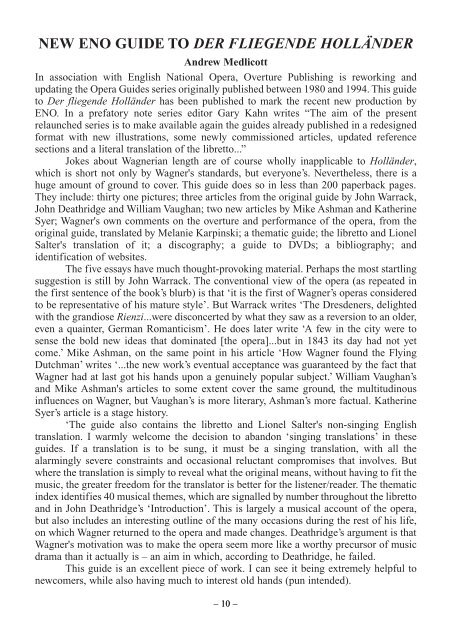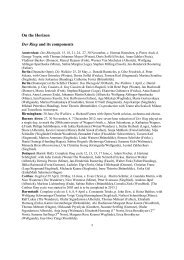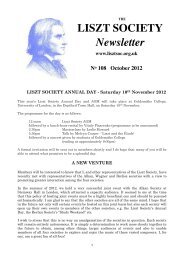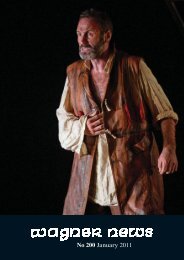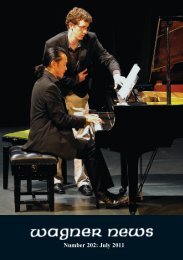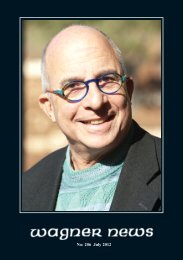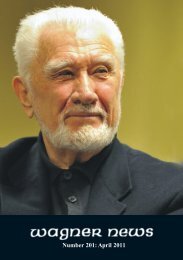13895 Wagner News 174 - Wagner Society of England
13895 Wagner News 174 - Wagner Society of England
13895 Wagner News 174 - Wagner Society of England
You also want an ePaper? Increase the reach of your titles
YUMPU automatically turns print PDFs into web optimized ePapers that Google loves.
NEW ENO GUIDE TO DER FLIEGENDE HOLLÄNDER<br />
Andrew Medlicott<br />
In association with English National Opera, Overture Publishing is reworking and<br />
updating the Opera Guides series originally published between 1980 and 1994. This guide<br />
to Der fliegende Holländer has been published to mark the recent new production by<br />
ENO. In a prefatory note series editor Gary Kahn writes “The aim <strong>of</strong> the present<br />
relaunched series is to make available again the guides already published in a redesigned<br />
format with new illustrations, some newly commissioned articles, updated reference<br />
sections and a literal translation <strong>of</strong> the libretto...”<br />
Jokes about <strong>Wagner</strong>ian length are <strong>of</strong> course wholly inapplicable to Holländer,<br />
which is short not only by <strong>Wagner</strong>'s standards, but everyone’s. Nevertheless, there is a<br />
huge amount <strong>of</strong> ground to cover. This guide does so in less than 200 paperback pages.<br />
They include: thirty one pictures; three articles from the original guide by John Warrack,<br />
John Deathridge and William Vaughan; two new articles by Mike Ashman and Katherine<br />
Syer; <strong>Wagner</strong>'s own comments on the overture and performance <strong>of</strong> the opera, from the<br />
original guide, translated by Melanie Karpinski; a thematic guide; the libretto and Lionel<br />
Salter's translation <strong>of</strong> it; a discography; a guide to DVDs; a bibliography; and<br />
identification <strong>of</strong> websites.<br />
The five essays have much thought-provoking material. Perhaps the most startling<br />
suggestion is still by John Warrack. The conventional view <strong>of</strong> the opera (as repeated in<br />
the first sentence <strong>of</strong> the book’s blurb) is that ‘it is the first <strong>of</strong> <strong>Wagner</strong>’s operas considered<br />
to be representative <strong>of</strong> his mature style’. But Warrack writes ‘The Dresdeners, delighted<br />
with the grandiose Rienzi...were disconcerted by what they saw as a reversion to an older,<br />
even a quainter, German Romanticism’. He does later write ‘A few in the city were to<br />
sense the bold new ideas that dominated [the opera]...but in 1843 its day had not yet<br />
come.’ Mike Ashman, on the same point in his article ‘How <strong>Wagner</strong> found the Flying<br />
Dutchman’ writes ‘...the new work’s eventual acceptance was guaranteed by the fact that<br />
<strong>Wagner</strong> had at last got his hands upon a genuinely popular subject.’ William Vaughan’s<br />
and Mike Ashman's articles to some extent cover the same ground, the multitudinous<br />
influences on <strong>Wagner</strong>, but Vaughan’s is more literary, Ashman’s more factual. Katherine<br />
Syer’s article is a stage history.<br />
‘The guide also contains the libretto and Lionel Salter's non-singing English<br />
translation. I warmly welcome the decision to abandon ‘singing translations’ in these<br />
guides. If a translation is to be sung, it must be a singing translation, with all the<br />
alarmingly severe constraints and occasional reluctant compromises that involves. But<br />
where the translation is simply to reveal what the original means, without having to fit the<br />
music, the greater freedom for the translator is better for the listener/reader. The thematic<br />
index identifies 40 musical themes, which are signalled by number throughout the libretto<br />
and in John Deathridge’s ‘Introduction’. This is largely a musical account <strong>of</strong> the opera,<br />
but also includes an interesting outline <strong>of</strong> the many occasions during the rest <strong>of</strong> his life,<br />
on which <strong>Wagner</strong> returned to the opera and made changes. Deathridge’s argument is that<br />
<strong>Wagner</strong>'s motivation was to make the opera seem more like a worthy precursor <strong>of</strong> music<br />
drama than it actually is – an aim in which, according to Deathridge, he failed.<br />
This guide is an excellent piece <strong>of</strong> work. I can see it being extremely helpful to<br />
newcomers, while also having much to interest old hands (pun intended).<br />
– 10 –


